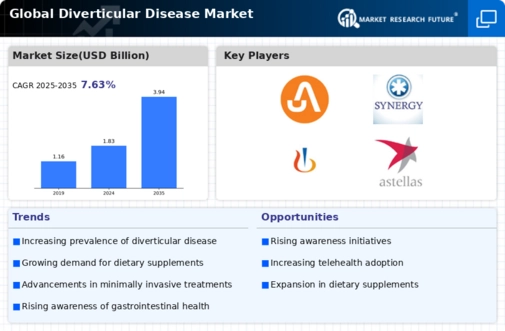Market Share
Diverticular Disease Market Share Analysis
The diverticular disease market is changing significantly due to the improvement of old age populations [sic], dietary habits, and medical understanding (Euromonitor International 2013). On the other hand, there is an ever-constant need for efficient treatments and strategies, such as those that could help control symptoms caused by diverticulitis (Canavan et al., 2014). Additionally, today's Diverticular Disease Market experiences a greater amount of innovative therapeutic options beyond traditional approaches (Tursi et al., 2015). Consequently, although dietary changes have remained central to managing symptoms together with antibiotics and anti-inflammatory agents, there has been an increasing focus on probiotics as against symbiotic preparations aimed at restoring gut microbiota balance (Tursi et al., 2015). The market is also experiencing a surge in the use of minimally invasive procedures for diverticular disease, particularly with respect to complications such as diverticulitis. Laparoscopic surgeries and other endoscopic interventions have become more common, allowing patients to enjoy less invasive treatment options, shorter recovery periods, and better postoperative outcomes. Partnerships between pharmaceutical companies, medical device manufacturers, and research institutions are driving the Diverticular Disease Market. These partnerships create a collaborative environment that facilitates the exchange of information and resources aimed at accelerating innovation in research and development for new products. There has been increasing adoption of telemedicine and mobile applications for managing diverticular disease as digital health solutions gain traction in healthcare. Remote consultations, monitoring, and patient education are possible through these technologies, making healthcare services more accessible while empowering individuals to take part in their healing processes. Demographic changes towards an aging population impact the Diverticular Disease Market as the prevalence tends to grow with age. As a result, pharmaceutical companies have increased their research and development efforts targeting this specific category of patients who are older compared to others in society. These evolving age-specific therapy approaches consider morbidity as well as potential complications among geriatric individuals.







Leave a Comment